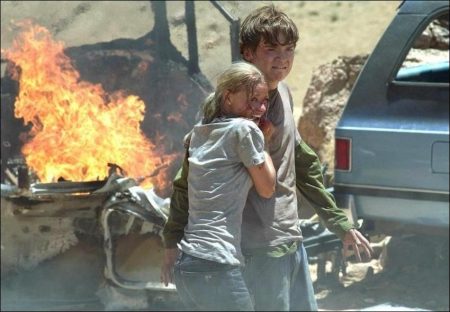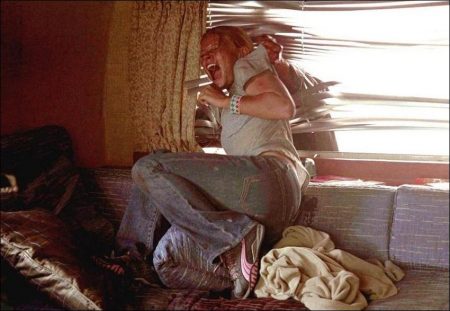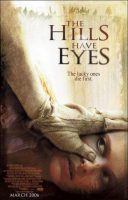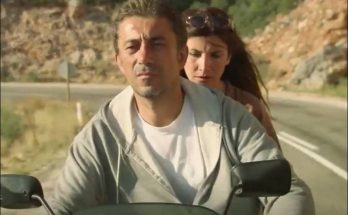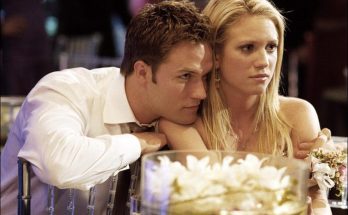Tagline: The lucky ones die first.
A new take on Wes Craven’s 1977 film of the same name, The Hills Have Eyes is the story of a family road trip that goes terrifyingly awry when the travelers become stranded in a government atomic zone. Miles from nowhere, the Carters soon realize the seemingly uninhabited wasteland is actually the breeding ground of a blood-thirsty mutant family…and they are the prey.
In the annals of modern fear, few films have had as deep an impact as Wes Craven’s 1977 cult classic The Hills Have Eyes. With its gritty, ferocious and relentlessly suspenseful tale of a vacationing family who suddenly face a desperate battle for survival, the low-low-budget but no-holds-barred film was resonant with both intriguing themes and outrageous shocks to the nervous system.
Now, inspired by the wild imagination of suspense-master Craven– who serves as producer along with Marianne Maddalena and Peter Locke — comes a contemporary reinterpretation of The Hills Have Eyes from the cutting-edge young filmmakers, Alexandre Aja and Gregory Levasseur, whose recent hit High Tension won acclaim and controversy for raising the bar on horror films again with its graphic, white-knuckle take on psychological terror.
Aja and Levasseur bring this chilling horror story of ever-intensifying dread hurtling into the 21st century, refashioning it with a raw, gut-wrenching realism and hard-driving visual style to terrify a whole new generation of filmgoers.
It all begins with a typically dysfunctional cross-country family road trip. It’s the wedding anniversary of rugged Cleveland police detective “Big Bob” Carter (Ted Levine) and his chatty wife Ethel (Academy Award nominee Kathleen Quinlan) and to celebrate, Bob’s asked his extended family to cruise to California with them, hoping the joys of the open road might help fuse their frayed connections. No one is particularly happy about it.
Eldest daughter, Lynn, (Vinessa Shaw) worries about her new baby’s safety and comfort while her husband, mild-mannered tech geek, Doug (Aaron Stanford), worries about close encounters with his father-in-law. Meanwhile teen daughter, Brenda, (Emilie De Ravin) detests the idea of leaving her friends for a family bonding trip, while young prankster Bobby, (Dan Byrd) is anxious to entertain the family’s two German Shepherds, Beauty and Beast. Nevertheless, the entire clan piles into a weathered Suburban pulling Bob’s beloved ’88 Airstream trailer and heads west.
Then, Big Bob takes a detour. Suddenly, the Carter family finds themselves in a desolate stretch of desert, with nothing seemingly alive for miles. When they run into a little unexpected vehicle trouble, they realize they are in dire straits, far from help, with a relentlessly sweltering desert sun overhead. But even as they fight to survive the deadly desert, a far greater threat emerges. Now the Carters become aware that they are not quite as alone as they first thought.
There is another group of survivors in the hills surrounding the desert: a genetically mutated, insatiably hungry, blood-thirsty clan — the terrifying offspring of miners left behind in the days when atomic tests spread radioactive fallout across the desert — who will stop at nothing to prey on the Carters one by one. Facing the very depths of savagery, the Carter family must pull together if they are to find any hope of returning to civilized life again… alive.
The Hills Have Eyes: Then and Now
In a career spanning more than three decades, Wes Craven has become a worldwide cultural phenomenon in film, television, and literature. He reinvented the youth horror genre in 1984 with the classic A Nightmare On Elm Street, which he wrote and directed, and in the next decade, he deconstructed the genre again with the mega-successful Scream trilogy. These two franchises alone have earned nearly a billion dollars and serve as a powerful demonstration of Craven’s profound understanding of the oftenunconscious desires and fears roiling in the human psyche.
“He’s a terrific storyteller, a compelling writer and a wonderful director,” says Hills producer Peter Locke, who produced, financed and distributed the original film in 1977. “He’s the master of the horror genre because he had early success in it and he’s figured it out probably better than anyone around.”
Craven’s success in probing the nature of fear began in 1972 with his first film, The Last House on the Left, and was taken to a whole new level of mastery with his second film, The Hills Have Eyes which quickly became part of the cultural zeitgeist with its unflinching tale of a mutant family preying on travelers in a government atomic zone.
Craven wrote the script after being inspired by the infamous true tale of Scotland’s 17th Century Sawny Beane family, who ambushed travelers on lonely village roads, killed them in unspeakable ways and then, shockingly, cannibalized their victims, living off their remains. The story recounts that through inbreeding the Sawny Beane family numbered as many as 48 members and murdered countless travelers. King James I of Scotland ultimately sent in some 400 soldiers and bloodhounds to hunt down the family’s hiding place: a blood-soaked cave of horrors. After they were captured, the King had the entire family executed in the same manner as they had killed their victims.
For Craven, this powerful ancient story seemed to tap right into our most resonant modern fears – fears about the clash between our yearning for civilization and our human propensity for unthinkable brutality and mad behavior. Moving the story into 20th century America, Craven also saw an opportunity to explore what he terms “the shadow side” of the American family – as his suburban clan faces off against the far more primal members of the mutant family.
These were the days before big-budget horror movies, and the original version of The Hills Have Eyes was made with a skeleton crew of just 15 members for a paltry $325,000 in the desert community of Victorville, CA. Things were so tight that producer Peter Locke drove the cast to locations in a beat-up Winnebago and the crew wore garbage bags for rainslickers when the weather turned stormy. Props were scavenged from Tobe Hooper’s horror classic The Texas Chainsaw Massacre and an abandoned gas station was found to create the film’s key set. The film was shot with a handheld 16mm camera, lending it a gritty look that only heightened the terror.
Despite its humble production, The Hills Have Eyes broke box-office records when it was released in the summer of 1977. Audiences were literally stunned by what they saw and critics were shocked and baffled. Unlike conventional horror films of the time, with their predictable monsters and comprehensible killers, this film boldly pushed the farthest edges of cinematic horror past long-held taboos and opened the way for today’s unflinching cinematic investigations of fear. It became a classic, influencing numerous future horror films and jarring viewers with its emotional fever pitch well into the DVD age.
Flash forward 30 years… now, intrigued by the astonishing success of such horror remakes as The Texas Chainsaw Massacre and Amityville Horror, Craven and his producing partners began pondering the possibility of revisiting The Hills Have Eyes – but with the heightened storytelling power of today’s far more advanced cinematic tools. Craven explains: “Because the original had been produced on such a minuscule budget, there were many aspects of the story I simply couldn’t afford to explore. Fortunately, the new version has a much bigger budget so we were able to greatly expand the production’s scope and take more time and care in shooting.”
In order to re-introduce this horror classic to contemporary audiences, Craven knew it would take upto- the-minute verve and style, so he and his production team began to look for a rising young director to bring fresh perspective to the project. The position was going to be extremely tough to fill. It would require an authentic visual innovator — someone with not only a dark and distinctive imagination but a unique talent capable of revisiting the dynamic action, gallows humor and edge-of-your-seat terror of the landmark film, while fusing them into an entirely new experience.
Ever on the lookout for exceptional filmmakers, Wes Craven’s longtime producing partner Marianne Maddalena was dazzled when she saw Alexandre Aja and Gregory Levasseurs’ 2003 French film High Tension, a blood-drenched tale of serial murder and mayhem that served as an ode to 1970s American horror/slasher movies. After viewing the film, Maddelena called Craven and Locke to tell them they must see it at once.
Locke, Craven and his entire production team were equally impressed by High Tension and its provocative, fresh approach to the frequently over-worked genre. “We all agreed it was brilliant,” says Marianne Maddalena. Moreover, the independently produced, low-budget film had exemplary production values, demonstrating to Craven, Maddalena and Locke that Aja and Levasseur were savvy filmmakers who could be highly creative within severe financial constraints.
Often credited with a keen eye for spotting burgeoning talent, and having previously discovered such screen luminaries as Sharon Stone and Johnny Depp, Craven took little convincing that Aja and Levasseur were the right filmmakers to rework his classic film. “With High Tension, Alex and Gregory demonstrated a multi-faceted understanding of what is profoundly terrifying,” comments Craven. “After viewing the film and then meeting the film makers, I knew I wanted to work with them.”
Only 27 years old, Alexandre Aja had spent his formative years assisting his director father Alexandre Arcady on exotic locations around the world. At 10, he met his best friend and long-time collaborator Gregory Levasseur, who would become a visionary screenwriter and art director. At 18, Aja and Levasseur’s Over The Rainbow received a Cannes Film Festival nomination for Best Short Film. Three years later, their first feature, FURIA, was nominated for a Fantasporto International Fantasy Award for best film. Then, the pair caused a sensation at the Toronto and Sundance Film Festivals with High Tension, resulting in a wide U.S. release and broad popularity for the small French film.
Aja and Levasseur immediately responded with excitement and passion to the unique proposition of approaching the story of The Hills Have Eyes with their own fresh vision. For these two cinema addicts, it was a dream come true — the chance to re-imagine one of their favorite films, under the supervision of its original creator yet with the freedom to take it in new directions. They had come as close to nirvana as horror fanatics can get.
“Wes Craven was one of our childhood heroes,” Aja notes. “We grew up watching all of his movies and that was really what got us into horror movies in the beginning. Greg and I actually bonded over one of his movies, Shocker, and The Last House on the Left served as a huge inspiration when we made High Tension. So given all that, we couldn’t possibly have been happier.”
The filmmaking duo was especially thrilled at the prospect of going even further with the story’s graphic probing of fear and even deeper into the character’s individual struggles for sheer survival than had been possible before. Further inspired by such American survival classics as Deliverance, Aja saw the film as a chance to look at human nature under the most extreme pressure. “For us this film was the perfect follow-up after High Tension because it was a chance to go another step beyond in the fear process,” Aja says. “I love it when you are watching a movie and it’s impossible to drink a soda or eat popcorn because you are too into the story. The Hills Have Eyes is exactly that kind of movie.”
Additionally, Aja and Levasseur were drawn to the film’s evocation of family – with its diametrically opposed portraits of a relatively normal, if typically flawed, suburban family trying to come together and their literally deformed, depraved, instinct-driven, mutant counterparts. “The idea of making a survival/horror movie about a family and not a bunch of teenagers was very attractive,” says Aja. “When you have a family like the Carters, you have an opportunity to explore so many different characters with so many different behaviors facing the danger. That was very interesting and allowed us to build some very different scenes with each of them. I think that members of the audience will each identify with the mother, sister, brother or son-in-law – and the experiences are always more real and more disturbing when you really care for the characters.”
Aja and Levasseur began by reworking the original Hills script, pulling it into 2006. Aja remembers, “Wes was a perfect gentleman and said, ‘I already made my movie and I really respect your vision so I want you to make your own movie.’ Instead, he asked us to find a new approach to the original. I think it was just a week later when we came in with some ideas about working the nuclear testing into the fabric of the story. “
Aja and Levasseur’s vision for the nuclear test site – with its eerie facsimile villages, family mannequins, and radiated ruins – and for the authentic radiation-caused deformities of the mutant family began to imbue a whole new level of gnawing realism to the already shocking story. Comments Craven: “The theme of nuclear radiation on humans is very timely. The general population today has little idea how dangerous nuclear fallout can be.”
Another aspect of Hills that intrigued Levasseur was the brief but extremely eventful time span the film covers. “When you’re dealing with a very short amount of time – just one night of action — you get a very interesting arc,” says Levasseur. “You start at a point where everyone is clean and good looking and you finish with all the clothes distressed, covered with blood, and the people wounded, barely alive. The evolution is really big and I think it’s very exciting whenever there is such a big contrast between the beginning and the end of the film.”
From there the story evolved over a period of months, as Aja and Levasseur dove deeper and deeper into the film’s alarming and disquieting themes. “Our version is a remake, but at the same time it is more about fear, more about a real struggle for survival, more about a family facing something terrifyingly unknown. The object of making a horror movie is always to do your best to scare the audience, so I wanted this version to be even scarier and gorier than the original.”
For Aja, the key was finding the right mix between originality and homage, between updating and expanding the original setup of Hills without in any way diluting its uncompromised raw energy. “We disliked many of the remakes of classic horror films made in the last few years because they’re too much like music videos, too clean and not as scary and graphic as they should be,” Aja explains. “With this film, we were able to make exactly the movie that we wanted to see.”
Aja was particularly pleased to be directing his very first American production. “For me, going to Hollywood is a dream come true,” he says. “With the kinds of films we are making, being French isn’t important. If you know how to frighten people, you can do it in any language.”
The Hills Have Eyes (2006)
Directed by: Alexandre Aja
Starring: Dan Byrd, Emilie De Ravin, Ted Levine, Aaron Stanford, Kathleen Quinlan, Vinessa Shaw, Maisie Camilleri Preziosi, Laura Ortiz, Ezra Buzzington, Greg Nicotero
Screenplay by: Alexandre Aja, Gregory Levasseur
Production Design by: Joseph C. Nemec
Cinematography by: Maxime Alexandre
Film Editing by: Baxter
Costume Design by: Danny Glicker
Set Decoration by: Alessandra Querzola
Art Direction by: Grégory Levasseur, Tamara Marini
MPAA Rating: R for strong gruesome violence, terror throughout, and for language.
Distributed by: Fox Searchlight Pictures
Release Date: March 17 2006
Views: 58
